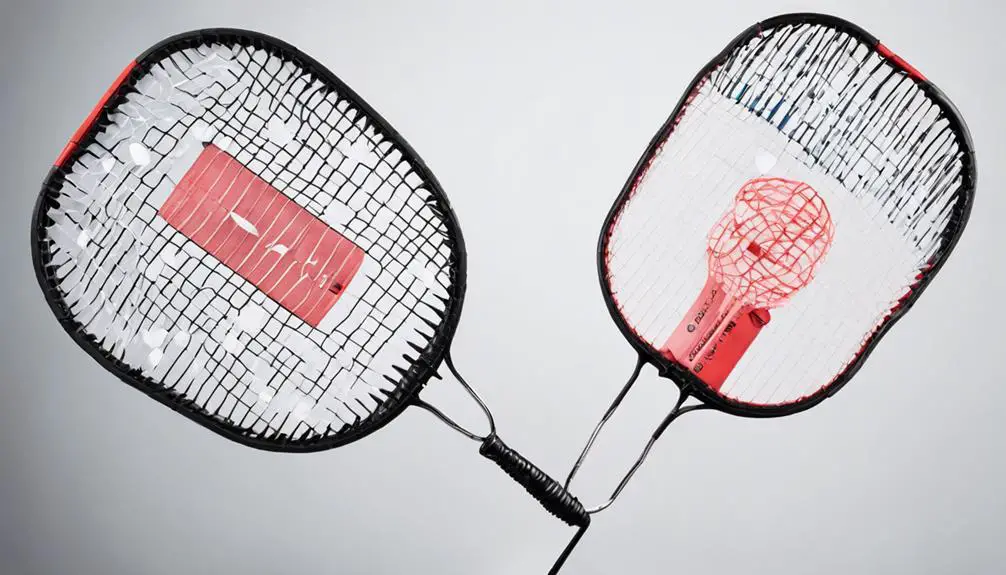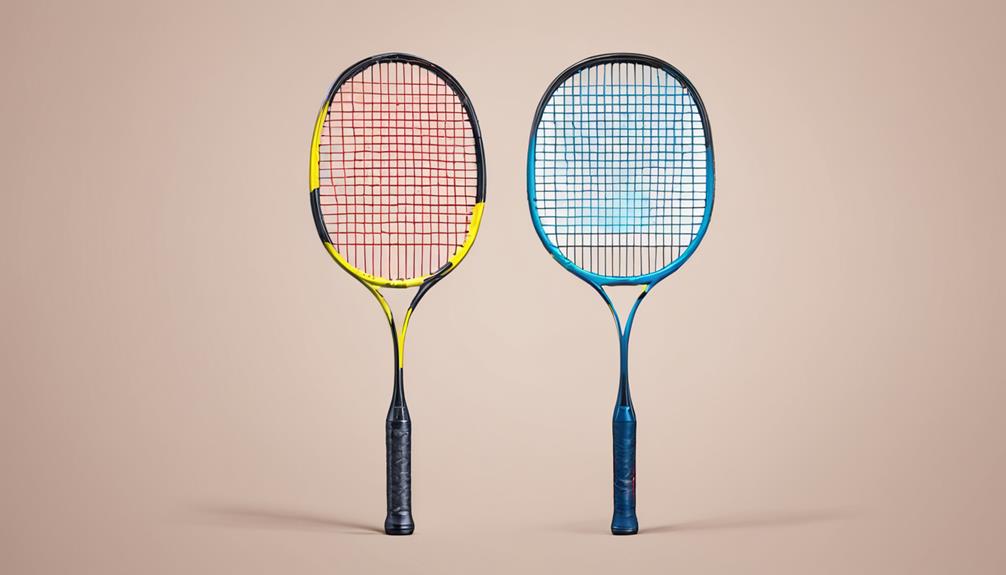When choosing a badminton racket, you'll encounter two main types: heavy and light. Heavier rackets, often preferred by singles players, offer powerful smashes and stability, but may strain your arm and shoulder. Lighter rackets, favored by doubles players and beginners, provide swift maneuverability and speed, but can lack shot power. Your playing style, skill level, and comfort should guide your decision. Consider factors like balance point, racket weight, and your individual needs to find the best fit. By exploring the nuances of racket types and weights, you'll uncover the ideal match to elevate your game.
Badminton Racket Balance Points Explained

Choosing the right badminton racket involves understanding its balance point, which plays an essential role in determining the racket's overall performance. You'll want to familiarize yourself with the three main categories of badminton racket balance points: Head-Heavy, Head-Light, and Evenly Balanced. A Head-Heavy Badminton Racket, with a balance point greater than 295mm, offers power and stability, making it ideal for aggressive players who prioritize offense.
On the other hand, a Head-Light Badminton Racket, with a balance point less than 285mm, provides enhanced maneuverability and control. This makes it suitable for defensive players and those who require quick reactions on the court. If you're looking for a balance between power and control, an Evenly Balanced racket, with a balance point between 285mm and 295mm, might be the way to go. These rackets are often favored by beginners and training players due to their versatility.
Understanding the balance point is vital, as it impacts your swing mechanics, shot types, and overall performance on the court. By choosing a racket with a balance point that suits your playing style, you'll be able to optimize your game and improve your overall freedom of movement on the court. Whether you're an experienced player or just starting out, recognizing the significance of badminton racket balance points will help you make an informed decision when selecting the right racket for your needs. By doing so, you'll be able to take your game to the next level.
Choosing the Right Racket Weight
When you're selecting a badminton racket, its weight is an essential factor to keep in mind, as it affects your swing speed, shot execution, and overall performance on the court. You'll want to reflect on the type of play you'll be engaging in and your personal skill level to determine the ideal racket weight for you. Lightweight rackets, typically under 78g, are great for beginners and doubles players who need enhanced maneuverability. They allow for quicker reactions and faster swing speeds, making them perfect for rapid-fire exchanges.
On the other hand, heavyweight rackets, over 88g, are often preferred by singles players who require increased stability and power in their shots. These rackets generate more forceful smashes, making them ideal for aggressive players. Normal weight rackets, around 83g, strike a balance between control and power, making them suitable for intermediate and advanced players.
Racket weight also influences playing style and comfort during matches. A heavier racket can lead to fatigue if you're not used to wielding it, while a lighter racket might not provide enough power for your shots. By reflecting on your playing style, skill level, and racket balances, you can choose a racket weight that complements your game. Ultimately, the right racket weight will allow you to move freely and confidently on the court, releasing your full potential. So, take the time to experiment with different racket weights to find the one that works best for you.
Head-Heavy Racket Pros and Cons

A head-heavy racket can be a game-changer for advanced players seeking to amplify their smashes and aggressive shots. With a balance point greater than 295 mm, these rackets concentrate weight at the head, providing the extra power you need to take your game to the next level. You'll notice a significant boost in shot power, making them particularly effective in singles and rear-court doubles play where offense is key.
One of the primary advantages of head-heavy badminton rackets is their ability to enhance stability during powerful swings. This increased stability allows for better control over aggressive shots, giving you the confidence to take on your opponents. However, it's worth noting that these rackets can be challenging to maneuver for beginners, potentially leading to strain on the arm and shoulder during extended play. To effectively handle the added weight, you'll need to develop the necessary strength and technique.
Despite the challenges, the benefits of head-heavy rackets far outweigh the drawbacks for advanced players. The weight of the racket, combined with its balance point, enables you to generate more powerful shots with less effort. This means you can focus on strategy and shot placement, rather than relying solely on brute force. By mastering the head-heavy racket, you'll release a new level of power and precision in your game, giving you the freedom to dominate on the court.
Head-Light Racket Advantages and Disadvantages
You'll find that head-light badminton rackets offer exceptional maneuverability, allowing you to quickly react to shots and make sharp movements around the court. However, this advantage comes with a trade-off: reduced power in your shots, which can be a significant drawback for players who rely on strong smashes. As you weigh the pros and cons of head-light rackets, consider whether the benefits of easy maneuverability outweigh the potential issues with power reduction.
Easy to Maneuver
In terms of maneuverability, head-light rackets have a distinct advantage. As a badminton player, you'll appreciate the ease with which you can swing and control these rackets, particularly during net play and defensive shots. The lighter weight at the handle reduces strain on your arm and shoulder, making head-light rackets ideal for beginners and players who prioritize comfort and control.
If you're a player with fast swing speeds, a head-light racket can be a great asset. These designs allow for quicker shot execution and improved accuracy during gameplay. Popular models like the Yonex Nanoflare 800 LT and Victor Auraspeed Light Fighter 40 D are recognized for their excellent maneuverability, making them favorites among agile players. With a head-light racket, you'll be able to react quickly and make precise shots, giving you a competitive edge on the court. By choosing a head-light racket, you'll be able to play with more freedom and confidence, focusing on your game rather than struggling with your equipment.
Power Reduction Issues
Several key factors contribute to the power reduction issues associated with head-light badminton rackets. When you use a head-light racket, you'll notice that the balance point is typically less than 285mm, which prioritizes speed and maneuverability over shot power. This means that while you'll have an easier time controlling the racket, particularly if you're a beginner or defensive player, you might struggle to generate enough power for smashes and aggressive shots.
The design of head-light rackets emphasizes quick reactions and precision over strength in shots, which can result in a decrease in shot power. Additionally, the lighter weight of these rackets, while beneficial for reducing strain on your arm and shoulder, can also make it harder to generate momentum for powerful shots. To compensate, you'll need to develop fast swing speeds to generate enough power. Overall, the power reduction issues with head-light rackets are a trade-off for their advantages in speed and control. By understanding the racket balance and its effects on shot power, you can make an informed decision about whether a head-light racket is right for your playing style.
Evenly Balanced Racket Benefits

You'll find that evenly balanced rackets are ideal for beginners, as they allow for a neutral playing style that doesn't favor power over control or vice versa. With a balance point that falls between 285mm and 295mm, these rackets offer a stable and handling-friendly design that facilitates effective gameplay. By using an evenly balanced racket, you'll be able to develop your skills without being forced into a specific playing style, making it easier to adapt to different shot techniques and strategies.
Ideal for Beginners
One key advantage of evenly balanced badminton rackets is that they're ideal for beginners. As a newcomer to the sport, you'll want a racket that won't overwhelm you with its weight distribution, allowing you to develop both power and control. Evenly balanced rackets provide a neutral feel, making them perfect for learning the basics. With a balance point typically ranging between 285mm and 295mm, these rackets are versatile and can accommodate various playing styles, giving you the freedom to experiment and find your preferences.
As you focus on improving your technique, an evenly balanced racket will provide stability and handling, making it easier to maneuver and control. This will help you choose the right shots and execute them effectively, leading to better performance on the court. Furthermore, evenly balanced rackets can support effective gameplay, allowing you to shift smoothly into more advanced styles as you gain experience and skill. By choosing an evenly balanced racket, you'll enjoy a more enjoyable learning experience, and it will help you progress in your badminton journey.
Neutral Playing Style
When it comes to adopting a neutral playing style, an evenly balanced racket can be a game-changer. With its weight evenly distributed, this type of racket offers a neutral feel that caters to various playing styles, making it suitable for both offensive and defensive strategies. You'll find that evenly balanced rackets have a balance point ranging between 285mm and 295mm, providing stability and handling that facilitates effective gameplay for beginners and training players.
| Benefits | Description |
|---|---|
| Versatility | Allows adaptation to different game situations and shot types with ease |
| Shot Consistency | Improves consistency in shots, making it ideal for those learning to master the fundamentals |
| Maneuverability | Enhances overall racket handling, allowing for quick movements and reactions |
| Balance | Offers a balance between power and control, making it perfect for players developing their skills |
Racket Weight and Playing Style
Concerning optimizing performance on the badminton court, the weight of the racket plays an essential role in determining a player's overall playing style. You'll find that racket weight notably impacts your performance, and choosing the right weight can enhance your gameplay. Lightweight rackets, typically under 78g, are ideal for beginners and doubles players who require improved maneuverability and speed.
As you progress to intermediate and advanced levels, you'll likely favor normal weight rackets, around 83g, which offer a balance of control and power. This weight range allows for versatile play styles, making it suitable for players who like to mix up their shots. On the other hand, heavyweight rackets, over 88g, are beneficial for singles play, providing greater stability and power during smashes and aggressive shots.
The choice of racket weight also influences your swing mechanics. Lighter rackets allow for faster swings, while heavier rackets can enhance shot power but may require more physical strength to maneuver effectively. Understanding your personal play style and skill level is vital in selecting the appropriate racket weight, as these factors directly affect gameplay and overall performance on the court. By choosing the right racket weight, you can optimize your performance and play to your strengths.
Selecting the Ideal Racket Type

Taking into account the complexities of badminton racket design, selecting the ideal racket type can greatly influence your performance on the court. With various options available, you'll want to evaluate factors such as balance point, weight, and your personal playstyle to make an informed decision.
When it comes to balance point, head-heavy rackets (greater than 295mm) offer more power for aggressive play, while head-light rackets (less than 285mm) provide better maneuverability and control. Evenly balanced rackets (between 285mm and 295mm) are versatile and suitable for players of all levels.
| Racket Type | Balance Point | Characteristics |
|---|---|---|
| Head-Heavy | >295mm | More power, aggressive play |
| Head-Light | <285mm | Better maneuverability, control |
| Evenly Balanced | 285-295mm | Versatile, suitable for all levels |
| Lightweight | Under 78g | Easy handling, beginners/doubles |
| Heavy | Over 88g | Stability, power, singles players |
Your personal playstyle should also guide your selection. If you're an aggressive player, a head-heavy racket may be ideal for its smashing capabilities. On the other hand, defensive players might prefer a head-light model to enhance quick reactions. Don't forget to test different rackets before making a purchase, as individual preferences regarding weight and balance can greatly impact performance and comfort on the court. Ultimately, choosing the right badminton racket will help you release your full potential and enjoy the freedom to play your best game.
Frequently Asked Questions
Is It Better to Have a Light or Heavy Badminton Racket?
You're likely wondering which racket weight is best for you. It ultimately comes down to your balance preference, swing speed, and player skill. A lighter racket suits those with quicker swing speeds and emphasizes control, while a heavier racket favors powerful shots. However, it also increases injury risk. Consider your playing style and priorities to make an informed decision that balances performance with comfort and minimizes the risk of strain or injury.
Do Heavier Badminton Rackets Give More Power?
You're wondering if heavier badminton rackets deliver more power. With regard to power generation, heavier rackets tend to have an advantage due to their increased mass, particularly at the head. This affects swing dynamics, as the added weight can produce more momentum. Many professionals prefer heavier rackets for their impact resistance and stability. Ultimately, player preference plays a significant role, but heavier rackets can indeed provide a power boost, especially for aggressive players.
What Are the Advantages of Lightweight Badminton Rackets?
You'll appreciate the advantages of lightweight badminton rackets, which include enhanced maneuverability benefits, allowing you to react quickly at the net. Fatigue reduction is another plus, as the lighter weight causes less strain on your arm and shoulder. You'll also experience improved swing speed, resulting in better shot precision. Additionally, control enhancement is a significant advantage, enabling you to execute shots with more accuracy and ease.
Why Are Some Badminton Rackets Heavy?
You're probably wondering why some badminton rackets are ridiculously heavy, right? Well, it's not because manufacturers hate your arm and shoulder. It's actually about the racket materials, which provide stability and power. Heavy rackets cater to player preference for aggressive play styles, allowing faster swing speeds and more control. However, this also increases the injury risk, especially for less experienced players. So, it's all about weighing the pros and cons – or rather, the grams.




